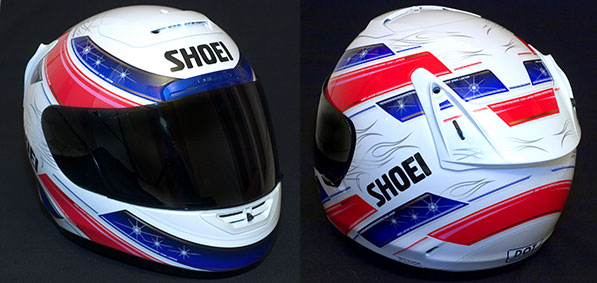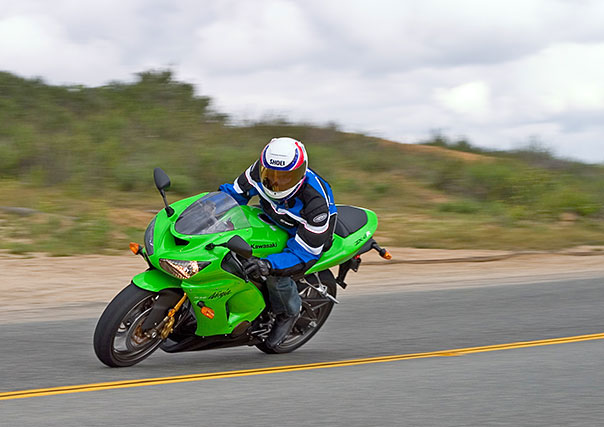
Helmets are the quintessential piece of protective equipment for motorcyclists, and there are literally hundreds of different helmets on the market today. Every rider has a different head shape, and anyone who’s been riding for a while probably has picked out a certain brand of helmet that fits their head comfortably.
For me, this brand is Shoei. One of the world’s premier high-end helmet manufacturers, Shoei (based in Japan) has been manufacturing motorcycle helmets for over 40 years. I’ve been wearing Shoeis for many years, and have always been impressed with the fit, finish, functionality, and overall quality.
Shoei’s current top-of-the-line model, the X-Eleven, continues that tradition. Designed with input from top-level roadracers like Eric Bostrom and Chris Vermeulen, the X-Eleven was tested and refined in Shoei’s wind tunnel to perfect it’s aerodynamic properties and ventilation system.
I’ve been wearing X-Eleven helmets for about two years now, with the latest addition to my helmet rack being the new-for-2006 Eddie Lawson Limited Edition pictured. At this point, I think I have enough experience with this model to share some of my observations with our readers.
The first thing you notice about the X-Eleven is its comfort. As I said earlier, different helmets fit different riders, but if the X-Eleven fits your head shape (as it does mine), you’d be hard-pressed to find a more comfortable piece. The padded mesh inner liner (removable for washing) has a smooth texture and is firm enough to keep the helmet safely in place without being uncomfortable.
For riders in hot climates (like here in Southern California!), ventilation is a crucial aspect of helmet performance. The X-Eleven has a total of five vents – one directly in front of the wearer’s mouth, one at the top edge of the faceshield, one high on the front of the helmet (this one has two intake holes), and two placed high up on the back of the helmet (one on each side). These vents work together to allow air to flow around the wearer’s head while riding, as well as direct airflow across the inside of the faceshield to prevent fogging.
It is a testament to the effectiveness of the X-Eleven’s ventilation system that I have never had a problem with my face or head overheating while riding with this helmet. Even when sweltering inside full leathers on a 100+ degree (fahrenheit) day, my head always remained comfortable (as long as I was moving, that is).
Despite the large number of air vents, the X-Eleven isn’t a very loud helmet. A certain amount of wind noise is inevitable, of course, but I never found the volume to be uncomfortable, even when riding significantly over 100mph without the benefit of earplugs (I never rode this fast on public highways, of course). Still, I try to remember to put in a pair of earplugs before heading out for long rides on the freeway, particularly on modern sportbikes, which offer little in the way of wind protection for the rider’s head. In the X-Eleven, I could live without them, but I figure it’s better for my hearing in the long run to wear them. Especially since I don’t have particularly great hearing to begin with – a legacy of too many rock concerts when I was younger, I suppose.
Back to the X-Eleven. I have to say that my favorite thing about this helmet (and all Shoei helmets) is the easy-to-use faceshield system. Keeping a variety of different faceshields in my garage (or my gearbag when on press intros), and changing them out to suit the conditions, is a necessity for me – since I wear prescription glasses, I don’t have the option of slipping on a pair of sunglasses under my helmet when it gets bright outside.
The Shoei faceshield attachment system is the most intuitive that I have encountered so far, and even without looking at the instructions, a Shoei owner could figure it out with a minimal amount of trial-and-error – as opposed to helmets from some other manufacturers, which may leave you scratching your head in bewilderment after 30 minutes of trying to swap from a clear shield to a tinted one.
The first time you look at the mechanics of the faceshield swapping system, you might get the impression that it would be easy to break – some of the small parts look fairly delicate. However, after using the system for several years, and often changing shields in a hurry, I have yet to break anything.
For those of you who live in cold and rainy climes, don’t think that the X-Eleven is a warm-weather only helmet. Far from it. Besides spending a lot of time riding on chilly nights, I spent a full day riding in pouring NorCal rain while wearing my X-Eleven, and it performed admirably in those conditions, as well.
In cold weather, I close all the vents except the one just above the faceshield – this keeps the majority of cold air out of the helmet, while allowing a small amount of airflow across the inside of the visor. I never had any problems with fogging as long as I kept that one vent open.
In heavy rain, you may be forced to keep all the vents sealed in order to prevent water from entering the helmet. In fact, I know you will, because when I tried riding in the rain with the faceshield vent open, I ended up with a bunch of water running down the inside of my visor. After closing all the vents, the helmet stayed dry inside, but I did have some minor problems with fogging. It wasn’t so bad that I had to stop, but if you spend a lot of time riding in the rain, I would suggest buying some sort of anti-fog system (whether a spray or a Fog City insert) to keep the faceshield from fogging up.
The final aspect of the helmet I’d like to mention is appearance. For many helmet buyers this is the only thing they consider, and while of course all of our readers are smarter than that, appearance still plays a big role in choosing a helmet. As with motorcycles, looks are always a matter of taste, but personally I love my Lawson paint scheme, and there are several other X-Elevens that are handsome enough that I wish I could own them as well (even journalists don’t get ALL the helmets they want!). In fact, Shoei has such a large variety of paint schemes available that everyone should be able to find at least one that they like. The X-Eleven comes in several solid colors and a few original paint schemes, plus a bunch of replicas that let you buy a helmet that looks just like a popular racer wears.
X-Elevens are painted at least partially by hand in their Japanese factory, and the graphics are applied by hand as well. The quality of the paint is awesome, and I can tell you from experience that the clear coat holds up well – my older X-Eleven has seen a lot of sun and even been rubbed up against a few rough surfaces (one time it even rolled across some rough asphalt), and it clearly has a finish that resists scratching and marking well.
The bottom line? If you can afford it, and it fits the shape of your head, the X-Eleven is certainly one of the finest helmets on the market today. It isn’t cheap (prices range from $580-590 for solid colors to the $690 range for racer replicas), but the quality fits the price.






